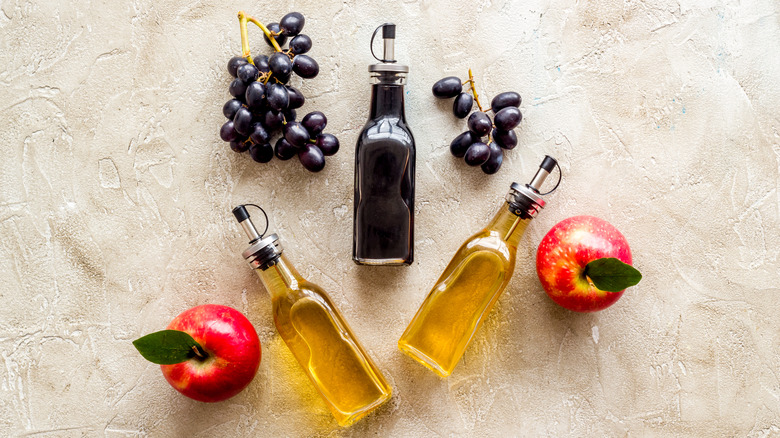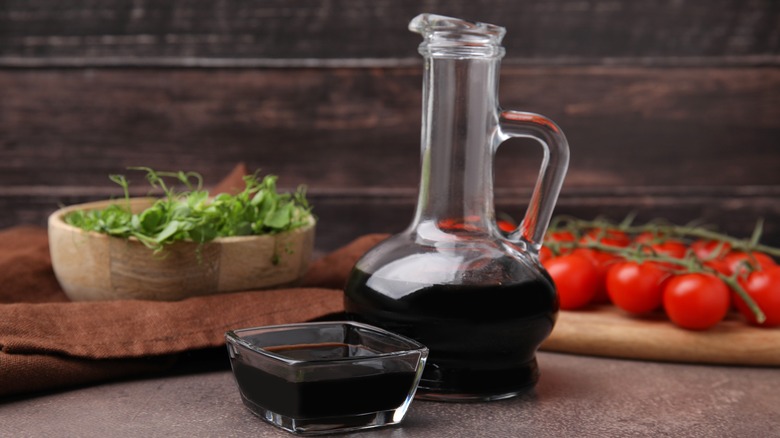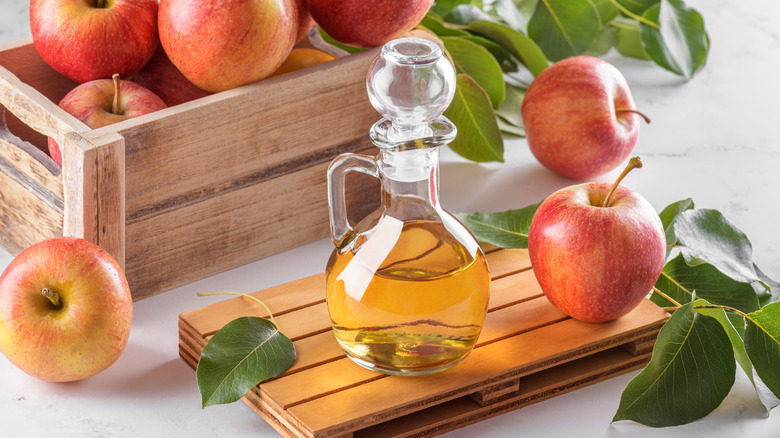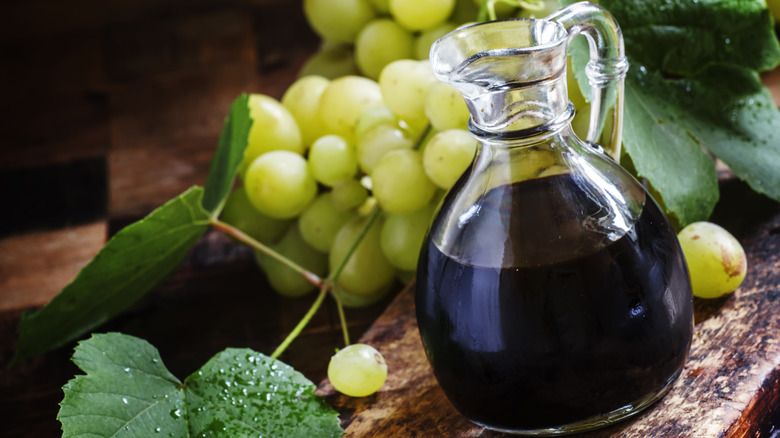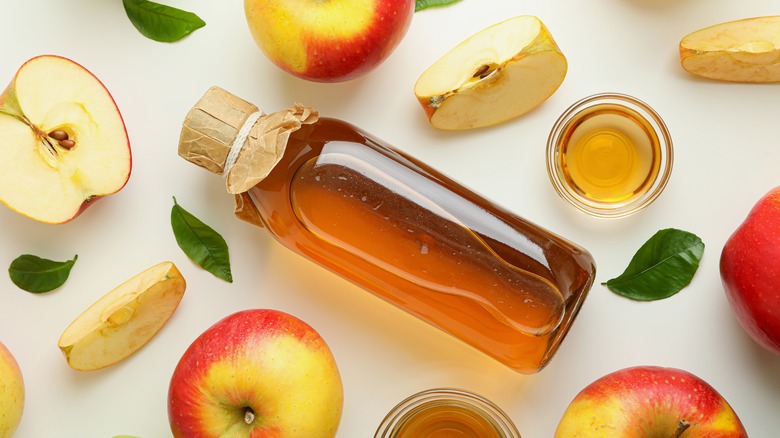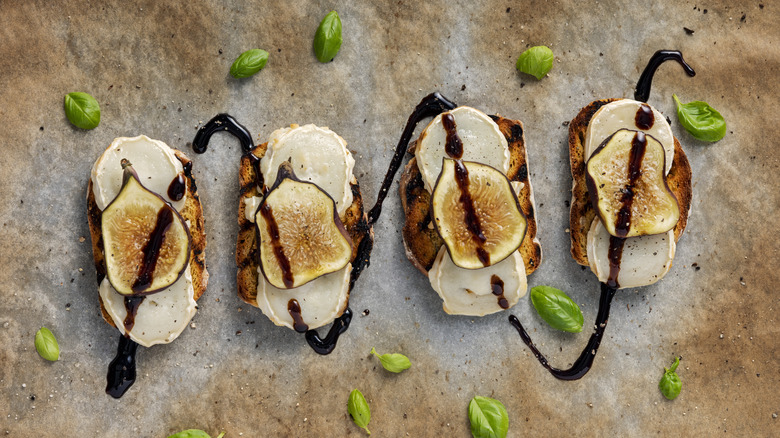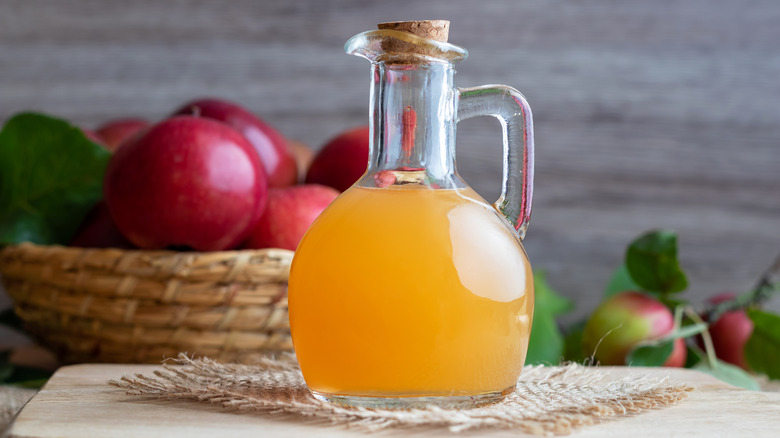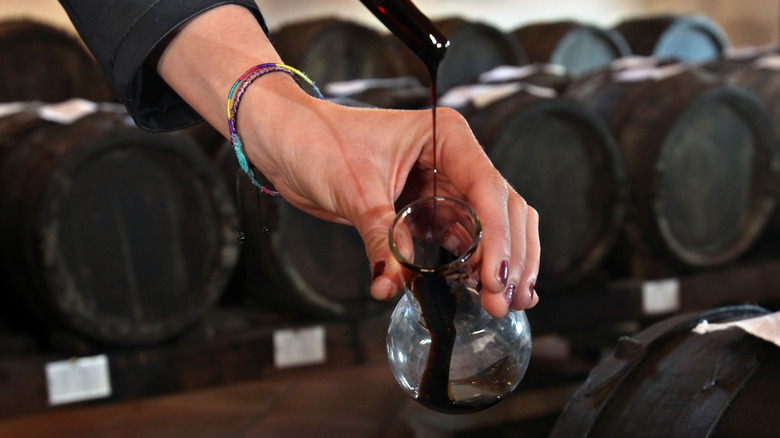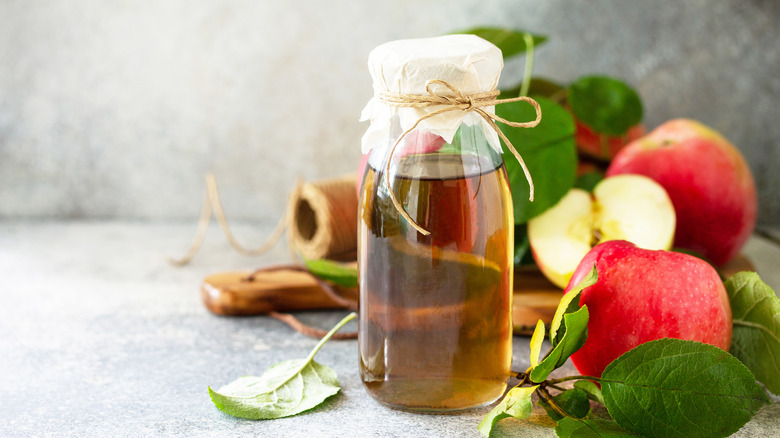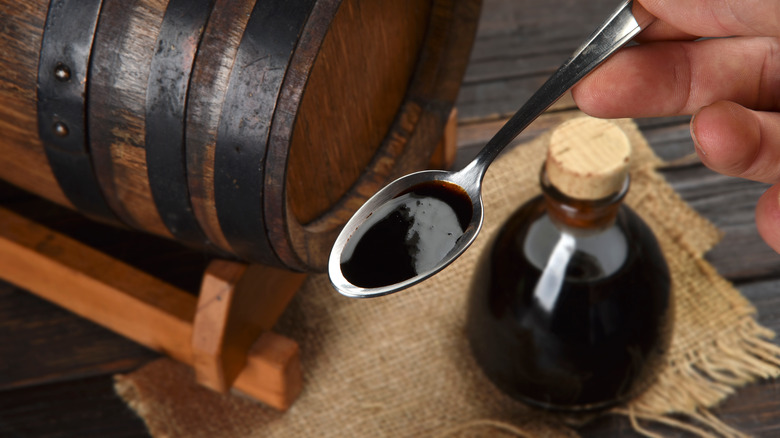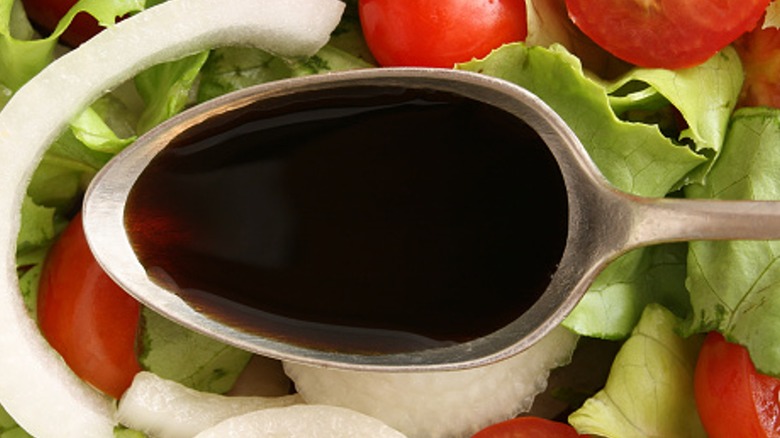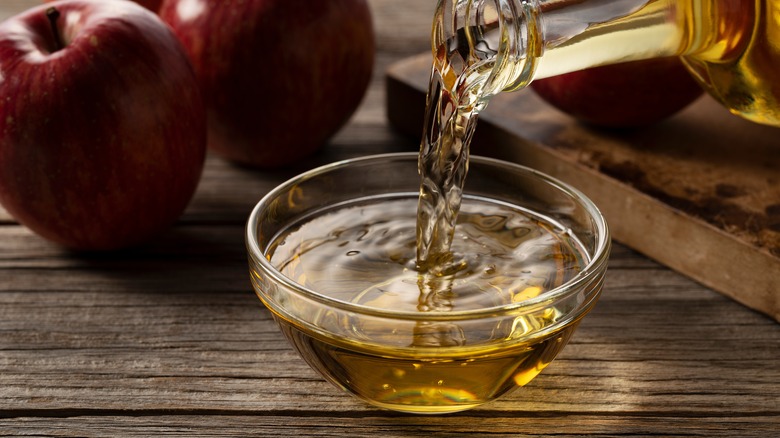Balsamic Vinegar Vs Apple Cider Vinegar: Everything You Need To Know
With many vinegar varieties available, two options in particular seem to have grown in popularity in recent years: balsamic vinegar and apple cider vinegar. While both give you a different flavor option than just the usual white vinegar you're used to, each has distinct qualities that suit certain situations. From the way it is made to its taste, uses, and price, it is worth knowing the difference between the two and understanding what each has to offer to your cooking experience.
To help you understand how balsamic vinegar and apple cider vinegar can best serve you in the kitchen, it might be helpful to understand some fundamental facts about these two flavorful ingredients. We tracked down the not-so-bitter truth about these two tangy elements to sweeten up the possibilities in your culinary adventures. Interestingly, while both substances are part of the vinegar family, they're almost nothing alike. We've got everything you need to know about balsamic and apple cider vinegar, and their delicious potential for flavor and function.
What is balsamic vinegar?
If you've seen balsamic vinegar on store shelves, you know its appearance is wildly different from any other vinegar. Its dark hue is closer to molasses, suggesting a rich, deep flavor from the umami side of the spectrum — perhaps similar to soy sauce. Balsamic vinegar is a gourmet ingredient made from the skin, seeds, and juice of ripened wine grapes, occupying a unique sphere in the culinary world. The components of balsamic vinegar are a notable departure from the starchy foods used to produce the more familiar white vinegar, and the result is a more syrup-finished product.
When balsamic vinegar appears in recipes, the difference is notable. Vinaigrettes become bolder and more full-bodied — a more complex version of the usual dressing — and dishes with a balsamic drizzle on top take on notably sweet and zesty notes that other vinegars can't deliver. Deep and opaque, a balsamic reduction will thicken the substance into a sturdier fluid that holds its own over meat and vegetable dishes rather than soaking into the surface, giving both a flavor boost and a blast of visual interest. Rather than being a mere replacement for other types of vinegar, balsamic can even be used as a stand-alone ingredient.
What is apple cider vinegar?
As the name indicates, apple cider vinegar is made from fermented apples, combined with yeast and sugar. Often referred to as ACV, it's a robust vinegar with an aroma that some find offensive. However, that translates to a much more favorable flavor. Rather than imparting added sweetness, the apples provide a tartness that some find harsher than other kinds of vinegar, with a more pungent flavor and a translucent amber color that sets it apart. Though the flavors are notably different, the acidity levels of white vinegar and ACV are comparable, allowing them to be used interchangeably in many recipes, especially formulations for salad dressings and glazes.
The distinguishing odor of apple cider vinegar reminds some who smell it of dirty feet — a quality new users should be aware of before cracking open the lid! Once you get past the smell, you'll find a versatile vinegar alternative that's as common on grocery shelves as white vinegar, providing an easy alternative that's sometimes specifically called for in recipes. Having a bottle on hand in your pantry will invite experimentation and give you options beyond the basic bottled vinegar that can sometimes fall flat or become disappointingly familiar.
Balsamic vinegar in its truest form comes from Modena and Reggio Emilia, Italy
Just like authentic Champagne only comes from the Champagne region of France, authentic balsamic vinegar comes from a region between Modena and Reggio Emilia, two provinces in Northern Italy. Historic documents detail Roman emperor Henry III being given a form of exceptional vinegar in 1046, and by the late 13th century, vinegar production was in full force in Modena. The word "balsamic" was first documented around 1747 as a descriptor for types of vinegar from the area, produced in variations referred to as medium and fine. By the 19th century, full-fledged vinegar dynasties had been established and the substance had begun to gain a reputation in the international market.
How did vinegar this specialized become a hallmark of the area? The climate in these Italian regions produces grapes with the acidity and sugar required to generate balsamic's sought-after qualities. In 2009, the European Commission declared that true balsamic comes from only Modena and Reggio Emilia and bestowed a protected status to authentic balsamic vinegar created following the traditions of the region. As part of the process, the truest and best quality balsamic vinegar is called Traditional Balsamic Vinegar of Modena PDO and it must be aged for at least 12 years.
Apple cider vinegar comes in two forms, with and without mother
You may have seen different types of apple cider vinegar on store shelves and wondered what the distinction was. The clearer form has been filtered and pasteurized for purity, while the cloudier version includes a substance called mother (or the mother) a sludge resulting from the interplay between yeast and bacteria during the fermentation process. ACV with the mother left in is thought to be the most nutrient-rich form; shoppers using this vinegar for its potential health benefits often opt for the mother version to maximize its potency.
How different are these two versions of the same substance? Apple cider vinegar containing mother has a bolder flavor and maintains a higher concentration of probiotics, one of the most beneficial aspects of including ACV in your cooking practices. You can also use ACV with mother as a starter to create other kinds of vinegar, similar to how a sourdough starter is used to generate more sourdough mix. All of this new ACV generation is thanks to the yeast and bacteria retained in the mother, which may help you determine which type is best for your purposes.
Balsamic vinegar tastes sweeter than other vinegars
Of course, the popular balsamic vinaigrette is a familiar dressing featuring the unique taste of balsamic as a prime player. But rather than just imparting the tongue-tingling tang of other types of vinegar, balsamic vinegar's flavor notes tend toward the sweet side, so much so that it's sometimes used specifically to add complex sweetness to dessert recipes. It isn't unusual for balsamic fans to pour it directly from the bottle to top ice cream and fresh fruit in dessert creations that call for a special touch. This may sound like an unwise idea, but the complex flavor lends itself as a balancing agent for sweeter elements, similar to sour cream in a cheesecake or lemon juice in a pound cake.
The characteristic sweetness comes from the 3 grams of sugar found in every tablespoon of balsamic vinegar. This isn't added sugar; it's the residual sugar from the grapes released during the fermentation process. By contrast, non-balsamic vinegar contains a gram or less of sugar per tablespoon. Even red wine vinegar, another vinegar produced using grapes in wine form, doesn't carry the sugary aspect, singling out balsamic as a true novelty in the vinegar world.
Apple cider vinegar is quite affordable
If you've never priced apple cider vinegar, you might be pleasantly surprised to learn that this fun kitchen helper fits nicely in a modest shopping budget. Walmart carries a 16-ounce bottle under its Great Value label for around $2.32, a little less than a dollar over its Great Value white vinegar, depending on your location. Shopping for ACV in bulk may lead you toward Amazon, where a full gallon may run you around $5.99. That's a whole lot of vinegar for a reasonable price, letting you keep a supply on hand for tinkering with its best uses. Both Walmart and Amazon versions are filtered and pasteurized, giving you a more pristine view of how you might factor ACV into your cooking life.
For ACV with mother included, Kroger stores stock a 16-ounce bottle under its Simple Truth Organic banner for about $3.19, though you may find a slightly different price in your location. If having a better-known brand name on the label is your preference, you can find Bragg's raw organic ACV with mother on Amazon for around $12.99 for a two-pack of 16-ounce bottles.
Balsamic vinegar can be very expensive
Though balsamic vinegar is available with a range of costs, there's a definite price point for high-quality versions that flag it as a premium purchase. Aging plays a part in the process, much like wine, enriching the flavor and driving up the price for certain vintages. You'll find far lesser versions at your neighborhood grocer, like Kroger brand, priced at around $4.79 depending on location, but clearly not the exceptional version from Italy. If you're just looking to try it out, a modestly-priced bottle will certainly clue you in. When you develop a palate for richer experiences, you might pay more than $1,000 for something like the 100-year offering from Giusti, an authentic Modena version that comes in a corked 3.38-ounce bottle with a wax seal and a serving pipette for doling out just the right amount. Of course, there are prices between the two for balsamics that are sure to be to your taste; it's simply a matter of testing them out.
Something to be aware of: When buying high-end balsamic vinegar, you may be paying a great deal for an inauthentic product. A BBC report details that inauthentic balsamic vinegars may be cut with other ingredients, a reminder to check into the company selling the bottle you're interested in to make sure you're getting your money's worth.
Apple cider vinegar can be made at home
For the enterprising home chef, making apple cider vinegar is an opportunity to play food scientist. A simple process involves using apple scraps, your invitation to maximize your environmental conservation while minimizing kitchen waste. If you plan on making your own apple cider, transforming the remains into a batch of ACV is a great way to utilize what's left over to make your apples go even further. According to a recipe by The Prairie Homestead, peels and/or cores added to filtered, unchlorinated water, and sugar — in the quantity of one tablespoon per one cup of water — added to a clean jar gets your vinegar started. After two weeks of fermentation helped along by occasional stirring and skimming, you can discard the solids and let your vinegar age for another two to four weeks to develop the signature tartness. Any mother that results can be used for future batches.
Using organic apples for your ACV is, of course, the healthiest option. If you plan to test your fermentation skills with a batch of your own, consider making a special purchase to ensure your finished product is as mindful and beneficial to your health and dining life as possible. And if you have an apple orchard or tree in your yard, picking your own apples will give your vinegar an added dash of homestyle magic.
Balsamic vinegar creation is similar to wine making
The heritage of balsamic vinegar creation has much in common with winemaking practices, including the use of grapes, the conditions in which the grapes are grown, and the aging process. Like wine, balsamic is also aged in barrels to develop richer flavor; the requirement for traditional Modena and Reggio Emilia is at least 12 years, though it can age for much longer in some cases. And just like wine, the longer the aging, the better the vintage — and the more expensive the resulting vinegar.
Home winemakers can give balsamic vinegar production a try to avoid spending on pricey options, though the process is incredibly involved. According to Wine Spectator, a home vintner can use quality Italian grapes to create a syrup reduction that's then aged between six months and a year. Adding mother will start the fermentation, though the sugars should ferment naturally. From there, all you have to do is age it for 10 more years or so, transferring the batch to smaller casks as it reduces. Easy, right? Actually, a moderately-priced bottle might be an easier investment to make that doing it from scratch.
Apple cider vinegar may be good for your health
The possibilities for using apple cider vinegar as a form of holistic nutrition have captivated humans around the world since prehistoric times; Hippocrates even blended honey with ACV as a curative for an array of conditions as part of his medical practices. Dieticians recommend drinking ACV for its probiotic properties, as well as antimicrobial and antifungal possibilities. Dilution in clean water is highly recommended if you intend on drinking apple cider vinegar for health purposes; this will help distribute the concentration of acid to prevent stomach irritation.
There has been discussion that ACV can also aid in weight loss, as well as cholesterol and blood sugar reduction. If these possibilities are enticing to you, but the idea of drinking vinegar in any form is too much to stomach, you can easily add it to your salads as a simple dressing made from 1/4 cup each of apple cider vinegar and olive oil, plus a garlic clove or two, a shake of salt and pepper, and a splash of real maple syrup. Mix it all together and use it to toss a dinner salad or dip fresh veggies.
Balsamic vinegar has beneficial properties, too
Balsamic has its own suite of health benefits, many of which are similar to those of apple cider vinegar. Balsamic vinegar can help lower bad cholesterol thanks to the antioxidants present, assist in digestion due to the concentration of acetic acid, and help you control your blood sugar by being anti-glycemic. There are also suggestions that including balsamic vinegar in your diet can produce clearer skin and help with weight loss.
While these are all fantastic findings, the best way to make balsamic vinegar present in your health practices is to start using it in the kitchen. Start by mixing up an easy balsamic vinaigrette to store in the fridge and use as a marinade or dressing throughout the week. You can also create a balsamic glaze that's perfect for topping bruschetta or pasta with veggies. And if you're a daring epicurean who can't get enough creative uses for balsamic in your entrée and side dishes, try adding balsamic to your baking endeavors for sweet treats with depth and distinction.
Apple cider vinegar has a variety of uses in the kitchen
Having a bottle of apple cider vinegar on hand at all times can help you achieve some useful results in the kitchen and around the house. You can make a wholesome antibacterial cleaner out of ACV and water, and it makes for a great way to wipe down your counters where germs lurk. Pouring baking soda down your drain followed by apple cider vinegar can help break up clogs and eliminate lingering odors. If fruit flies are a problem, cover a small jar filled with ACV with plastic wrap and poke holes for the flies to enter; they'll be attracted to the scent and become trapped once they enter the jar.
Maybe one of the most surprising uses of apple cider vinegar is as a leavening agent in baked goods. The inclusion of ACV causes a reaction with baking soda, creating carbon dioxide that lightens cakes and other batters by producing bubbles. There are even simple cake recipes where apple cider vinegar does all the heavy lifting, with no eggs or dairy to help out — something that could appeal to vegans or those with certain food allergies.
